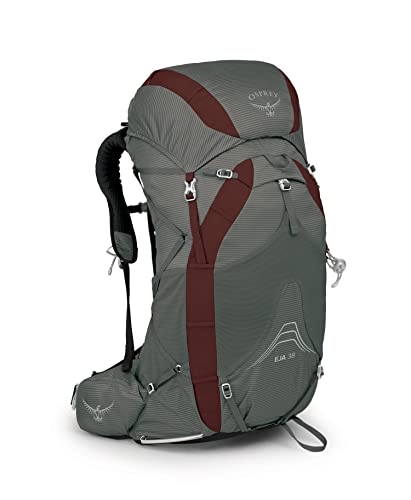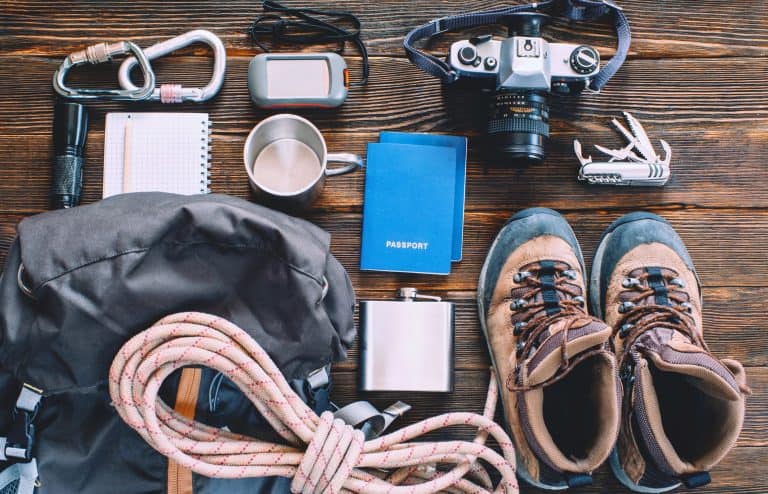Best Women’s Backpacking Backpacks of 2025: Tested in the PNW

Finding the best women’s backpacking backpacks can make or break your time on the trail, especially in the Pacific Northwest.
With rain-soaked forests, steep alpine climbs, and unpredictable weather, this region demands gear that fits well, carries smart, and holds up when conditions get rough.
After years of backpacking year-round through Washington and Oregon, I’ve tested these packs in the wild, from soggy Olympic loops to high-alpine nights in the North Cascades.
Ready to find the right pack for your next PNW adventure? These are the ones that actually held up.

Must-Have Backpacking Gear:
– Fastest Jetboil: Jetboil Zip
– Most Durable Hiking Poles: Black Diamond Alpine Poles
– Best Backpacking Boots: KEEN Targhee Waterproof Boots
Why Women’s Packs Matter & What to Look For
Most discomfort on the trail starts with a bad fit. I’ve had hip belts dig into my sides, bruises where there shouldn’t be bruises, and shoulder straps that cut in instead of supporting.
Thankfully, most major brands offer women-specific backpacks, and the difference goes far beyond the label. The women-focused backpacking backpacks are designed to help distribute weight evenly, minimize strain on your shoulders and hips, and improve stability on rugged trails.
With a pack that actually fits, you’re more likely to enjoy your trip instead of counting down the miles.
✨ Best Women’s Backpacking Backpacks for the PNW (2025 Picks)
This guide covers 5 women’s backpacking backpacks that have all been tested and reviewed in the great PNW. They have handled mud, rain, bugs, river crossings, alpine ridgelines, mossy valleys, and everything in between.
These lightweight backpacks are designed to help you hike farther, stay drier, and pack more mindfully. Here are my top picks, whether you’re an ultralight purist or a comfort-first backpacker.
🥇 1. Osprey Ariel 65
Weight: 4.9 lbs
Capacity: 65L
Best For: Heavy loads, rugged terrain, or winter trips
The Ariel 65 is built for long-haul comfort and rugged use. Its adjustable suspension and customizable fit make it a standout for carrying heavier loads without compromising on support. With access from the top, bottom, and front panel, organizing gear is easy, even on the go.
A built-in rain cover, hydration sleeve, and durable materials make this a dependable choice for multi-day trips or challenging terrain. Ideal for those who need both capacity and confidence in the backcountry.
Pros: Supportive for big loads, customizable fit, super durable
Cons: Heavier than most—overkill for ultralight setups
2. Osprey Eja 58
- Weight: 2.7 lbs
- Capacity: 58L
- Best For: Multi-day trips with comfort and balance
The Osprey Eja 58 is a favorite for women who want ultralight performance without sacrificing support. This pack nails that combo.
Its ventilated mesh Airspeed back keeps airflow consistent on hot climbs, and the suspension system adapts to your shape. With a removable lid and an adjustable harness, it’s great for dialing in your setup and customizing weight. It’s not waterproof, so pair it with a liner or rain cover.
Pros: Breathable, supportive, durable
Cons: Hip belt pockets are small
Backpacker’s Tip: When I was in the Army and needed a quick pack liner, I would use heavy-duty trash bags to keep all of my gear/clothes dry. Let me tell you, it worked great. (…and I still do it to this day)
3. Gregory Maven 58
Weight: 3.5 lbs
Capacity: 58L
Best For: Versatile backpackers who want comfort and adjustability
The Maven 58 hits that sweet spot between comfort, weight, and features. It has a dynamic FreeFloat suspension that moves with your body, making long climbs and technical sections more manageable. The ventilated back panel keeps airflow moving on muggy coastal trails or sunny ridge hikes.
If you ever decide to do the Timberline Trail on Mount Hood, the ventilated back panel is a must when you’re treking up an open face on loose scree.
Pros: Comfortable suspension, adjustable torso, and included rain cover
Cons: A bit heavier than minimalist packs
4. Gregory Deva 60
Weight: 4.6 lbs
Capacity: 60L
Best For: Heavy loads, extended trips, or anyone who prioritizes plush comfort
The Deva 60 is a workhorse, and honestly, one of the most comfortable packs I’ve ever tried for carrying big loads. The hip belt pivots with your stride, the suspension is incredibly supportive, and it has more pockets than you’ll know what to do with (mine are typically filled with snacks haha).
It’s heavier than the other packs on this list, but if comfort and load-hauling are your priorities, it’s worth every ounce.
Pros: Super comfortable, great suspension, excellent organization
Cons: Heavier than most packs on this list
5. REI Co-op Flash 55
Weight: 2.7 lbs
Capacity: 55L
Best For: Budget-conscious backpackers
This pack is modular, meaning you can add or remove components depending on your trip to lighten your load. Side pockets, top lid, and compression straps are all optional.
It’s a great intro to ultralight backpacking, especially if you’re experimenting with gear. I’ve used it on shoulder-season trips where I needed flexibility.
Pros: Affordable, adaptable, lightweight
Cons: Can feel floppy if under-packed
What to Prioritize When Choosing a Pack:
👉 Fit & Comfort
- Adjustable torso length
- S-curved shoulder straps (better for women’s frames)
- Contoured hip belts that actually sit on your hips
- Load lifters that pull the weight where it belongs — your hips, not your shoulders
👉 Weight
- Ultralight: Under 2.5 lbs — great if your gear is dialed
- Lightweight: 2.5–3 lbs — ideal balance for most hikers
💡 Lighter = less fatigue + more energy for the climb
👉 Weather Resistance
- Dyneema or treated fabrics help shed rain
- Always use a pack liner + rain cover
- Mesh pockets are great for drying gear on the go
- I always pack 2–3 Sea to Summit Dry Bags — one for clothes, one for layers, one for dirty gear. They’re waterproof and make packing so much easier.

👉 Capacity
- 45–65L is ideal for most 2–5 day backpacking trips
- Need plenty of room for a bear bag/canister, layers, and food
🐻 New to bear bags? Learn how to hang one before your trip — WTA’s guide is gold.
👉 Purpose
- Ultralight packs: Best for thru-hikers or minimalist setups
- Structured lightweight packs: Great for newer backpackers or carrying extras (like a camera setup)
Similar Posts with Gear Reviews / Recommendations:
– Best Women’s Hiking Boots
– Coalatree Trailhead Pants | Honest Review
– Backpacking Meals You Will Actually Want to Eat
How to Choose the Right Backpack for You
When you’re narrowing down the best women’s backpacking backpacks, prioritize fit above all else. Try on packs if you can. Load them up. Adjust everything. Look for structured support, shoulder comfort, and solid weight distribution. Fit is everything and fit is personal.
Tips for Testing:
- Try on packs in-store if possible
- Load them with weight (most outfitters let you test that)
- Adjust the torso, hipbelt, and shoulder straps properly
- Walk around for 10+ minutes and mimic real movement

Capacity Guide:
- 1–2 nights: 40–50L
- 3–5 nights: 50–65L
- 5+ nights or winter: 60–70L
Quick Fit Tips:
- Torso length should match your frame
- Hipbelt should sit above your hip bones and carry most of the weight
- Shoulder straps shouldn’t gap or pinch
PNW-Specific Backpacking Tips:
- Use a rain cover and a pack liner. Trust me.
- Bear canisters or bear hang systems are required in parts of Olympic and North Cascades NP (I personally always bring one)
- Use dry bags for organization and waterproofing
- Mindful travel means only bringing what you need—and choosing gear that supports both your body and the planet.
Stay on the trail and practice Leave No Trace. Keep our wild places wild. ✌️

Conclusion: Best Women’s Backpacking Backpacks
Finding the best women’s backpacking backpacks is a bit daunting at first. There are a lot of brands, a lot of specs, and a lot of random terminology you may have not heard before. Plus, there are a lot of options.
Remember that you want your backpack to feel like it is one with you. Not something that is dragging you down or causing hot spots. It’s more than just comparing specs. It’s about matching a pack to your body and your trips.
From minimalist Dyneema packs to adjustable suspension systems, these picks are tested in the wild, where weather, terrain, and mileage test every ounce.
Pack light, fit it right, and hit the trail with confidence.
Happy Trails,
Mindful PNW Travels










